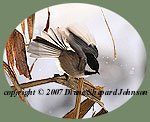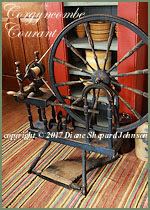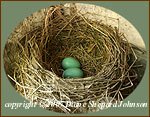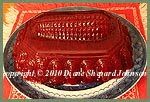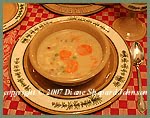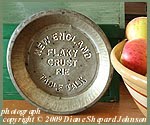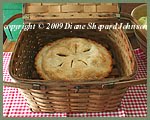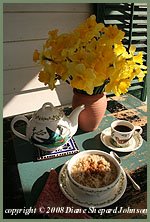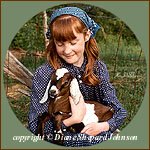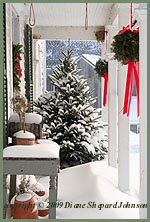In the old days children would go out and about in the woods, fields, hills, and dales and gather plant specimens for studying botany. A tin vessel with a tight fitting lid would keep the flower specimens fresh. This tin vessel is called a vasculum and has a strap for carrying over your shoulder.
The girls have gathered flowers, one lad is collecting butterflies, and if you look closely at the other lad you can see that he is collecting specimens in his vasculum.
 Diane lines the inside of the vasculum with moss and the plant specimens really do stay fresh for several days. The cover of this vasculum pictures goats, which we will feature in the future at The Corgyncombe Courant.
Diane lines the inside of the vasculum with moss and the plant specimens really do stay fresh for several days. The cover of this vasculum pictures goats, which we will feature in the future at The Corgyncombe Courant. The large door on the outside of the vasculum has pictured a girl and a boy in a playhouse under a table. The girl is holding her dolly and the lad is smoking a pipe. They are joined by a dog and a spunky puppy.
The large door on the outside of the vasculum has pictured a girl and a boy in a playhouse under a table. The girl is holding her dolly and the lad is smoking a pipe. They are joined by a dog and a spunky puppy.
 The smaller door shows children dipping their toes in the cool water. The little kerchiefed girl looks just like Sarah when she was little.
The smaller door shows children dipping their toes in the cool water. The little kerchiefed girl looks just like Sarah when she was little. In another old vasculum are Violas, Lily-of-the-valley, lawn daisy, pink violet, forget-me-nots, wild strawberries, and sweet woodruff.
In another old vasculum are Violas, Lily-of-the-valley, lawn daisy, pink violet, forget-me-nots, wild strawberries, and sweet woodruff. Coltsfoot, Lily-of-the-valley, forget-me-nots, Johnny Jump Ups, violet, lawn daisies, and on the end sweet woodruff. Excepting the coltsfoot, all of these pressed flowers are those shown in the vasculum above.
Coltsfoot, Lily-of-the-valley, forget-me-nots, Johnny Jump Ups, violet, lawn daisies, and on the end sweet woodruff. Excepting the coltsfoot, all of these pressed flowers are those shown in the vasculum above.
A press used for pressing and drying flowers.
 The flowers are sandwiched between pieces of blotter paper and cardboard. The wooden top of the press is placed on top and the screw is turned down to tighten. After they are pressed and dried they will be put in an Herbarium.
The flowers are sandwiched between pieces of blotter paper and cardboard. The wooden top of the press is placed on top and the screw is turned down to tighten. After they are pressed and dried they will be put in an Herbarium. "Eleven Girls Dancing" in the book "1 is One", written and illustrated by Tasha Tudor. The whole book is full of a variety of lovely flower borders. The stone holding the page is one of Diane's favorite stones which she found whilst traversing her acreage. Corgyncombe Cottage received a print of "Eleven Girls Dancing" from "Tasha Tudor and Family" the other day. Many of Tasha Tudor's books and illustrations contain flowers.
"Eleven Girls Dancing" in the book "1 is One", written and illustrated by Tasha Tudor. The whole book is full of a variety of lovely flower borders. The stone holding the page is one of Diane's favorite stones which she found whilst traversing her acreage. Corgyncombe Cottage received a print of "Eleven Girls Dancing" from "Tasha Tudor and Family" the other day. Many of Tasha Tudor's books and illustrations contain flowers. After a May Day celebration complete with May Pole, in the meadow Sarah and her cousins danced round in a circle in the late afternoon sun.
After a May Day celebration complete with May Pole, in the meadow Sarah and her cousins danced round in a circle in the late afternoon sun. "Song on May Morning"
Now the bright morning-star, day's harbinger,
Comes dancing from the east, and leads with her
The flowery May, who from her green lap throws
The yellow cowslip and the pale primrose.
Hail, bounteous May, that dost inspire
Mirth, and youth, and warm desire;
Woods and groves are of thy dressing,
Hill and dale doth boast thy blessing.
Thus we salute thee with our early song,
And welcome thee, and wish thee long.
- John Milton
The flowery May, who from her green lap throws
The yellow cowslip and the pale primrose.
Hail, bounteous May, that dost inspire
Mirth, and youth, and warm desire;
Woods and groves are of thy dressing,
Hill and dale doth boast thy blessing.
Thus we salute thee with our early song,
And welcome thee, and wish thee long.
- John Milton
 The above book, "The Flower Gatherers", by Jane Jay Fuller, is open to Chapter Second. 'Tis about a group of children who learn from Uncle John about the wild flowers as they are in flower throughout the months. The week before one of their lessons they gather every wild flower they find which they take to Uncle John to identify. In Chapter Third, as the moon is rising in the east, the children deliver May baskets to Uncle John's door. Uncle John was very touched and he said "So you have been Maying, and did not forget poor, old Uncle John!"
The above book, "The Flower Gatherers", by Jane Jay Fuller, is open to Chapter Second. 'Tis about a group of children who learn from Uncle John about the wild flowers as they are in flower throughout the months. The week before one of their lessons they gather every wild flower they find which they take to Uncle John to identify. In Chapter Third, as the moon is rising in the east, the children deliver May baskets to Uncle John's door. Uncle John was very touched and he said "So you have been Maying, and did not forget poor, old Uncle John!"In the previous chapter Uncle John had given the children tin buckets for gathering their specimens in: "After tea, he presented to each of us a little, tall, tin bucket, with a close-fitting cover, and said, they would be much nicer for flower-gathering than baskets, because they would exclude the air and retain moisture."
 A Botany book, a "Prize for Botanical Specimens" presented August 4th, 1896 to Vera Fisher from the school's Head Mistress M. Kendall.
A Botany book, a "Prize for Botanical Specimens" presented August 4th, 1896 to Vera Fisher from the school's Head Mistress M. Kendall. Lilacs are usually in bloom near Memorial Day. When Diane thinks of lilacs she thinks of going with her Grandmum, taking lilacs, putting them in canning jars and placing them on the graves of their ancestors. Graves are always decorated in remembrance of those who had gone before on Memorial Day.
Lilacs are usually in bloom near Memorial Day. When Diane thinks of lilacs she thinks of going with her Grandmum, taking lilacs, putting them in canning jars and placing them on the graves of their ancestors. Graves are always decorated in remembrance of those who had gone before on Memorial Day. "Under The Lilacs" written by Louisa May Alcott.
"Under The Lilacs" written by Louisa May Alcott.Diane's 5th great grandfather Eliakim May was 1st cousin to Louisa May Alcott's great grandfather Samuel May.
In "Under the Lilacs" the children study botany. Louisa May Alcott wrote:
"We are a Scientific Exploration Society, and we must keep an account of all the plants, animals, minerals, and so on, as we come across them. Then, suppose we get lost, and have to hunt for food, how are we to know what is safe and what isn't? Come, now, do you know the difference between a toadstool and a mushroom?"
"No, I don't."
"Then I'll teach you some day. There is sweet flag and poisonous flag, and all sorts of berries and things; and you'd better look out when you are in the woods, or you'll touch ivy and dogwood, and have a horrid time, if you don't know your botany."
"But both boys found a new pleasure in the pretty pastime they made of it; for active Ben ranged the woods and fields with a tin box slung over his shoulder, and feeble Thorny had a little room fitted up for his own use, where he pressed flowers in newspaper books, dried herbs on the walls, had bottles and cups, pans and platters, for his treasures and made as much litter as he liked."
"Presently, Ben brought such lively accounts of the green nooks where jacks-in-the-pulpit preached their little sermons; brooks, beside which grew blue violets and lovely ferns; rocks, round which danced the columbines like rosy elves, or the trees where birds built, squirrels chattered, and woodchucks burrowed, that Thorny was seized with a desire to go and see these beauties for himself."
When Diane was growing up there was a hedge of lilacs between her playhouse and the goat barn.
Ragged-Robin, Lychnis flos-cuculi, is beautiful now along the roadsides.

 "According to Season", written by Frances Theodora Parsons and illustrated by Elsie Louise Shaw, is about flowers throughout the seasons, starting with the earliest of flowers. Frances also speaks of birds. Also on the desk, the bird cards were cards that children could collect with information about the bird on the back.
"According to Season", written by Frances Theodora Parsons and illustrated by Elsie Louise Shaw, is about flowers throughout the seasons, starting with the earliest of flowers. Frances also speaks of birds. Also on the desk, the bird cards were cards that children could collect with information about the bird on the back. Iris Florentina is now in glorious and abundant bloom at the Corgyncombe Gardens.
Iris Florentina is now in glorious and abundant bloom at the Corgyncombe Gardens.
In several places Corgi Creek splits off and creates little islands. Diane and her husband took such a pleasant walk along Corgi Creek where the dame's rocket can be seen as far as the eye can see. The only thing one can hear is the babbling of the creek and birds singing. The rocket smells so sweet. It is a joy to the senses.... 'tis our own delightful paradise.
Dame's Rocket, Hesperis matronalis, often found at lawn's edge and where field meets wood, are in full bloom right now and are absolutely gorgeous. Their fragrance is lovely, especially at twilight. Dame's Rocket is Diane's favorite flower! They remind us of a Helen Allingham style painting...


The valley in spring.

Corgyncombe goat kiddle Louisa May is so cute!
The Corgyncombe Courant has more photographs of Louisa May and her sister Lucy that we hope to feature in a future edition of The Corgyncombe Courant.

If you would like to have a vasculum of your own, the talented tinsmith who made Diane's Tasha Tudor Reproduction Tin Kitchen (sold by "Tasha Tudor and Family"), also makes an 18th century and a 19th century vasculum.
Here is the link: Carl Giordano, Tinsmith: Vasculum
Here is the link: Carl Giordano, Tinsmith: Vasculum
Click "View photo" to see one of the vasculums.
~~~~~~~~~~~~~~~~~~~~~~~~~~~~~~~~

